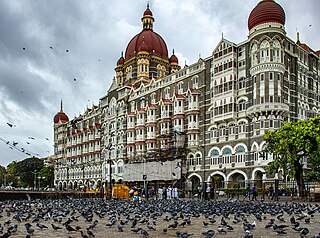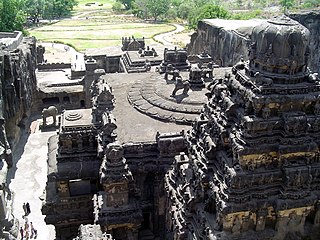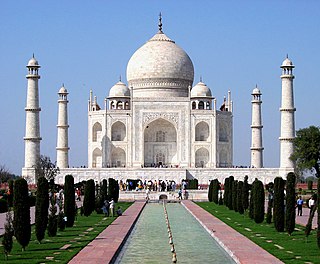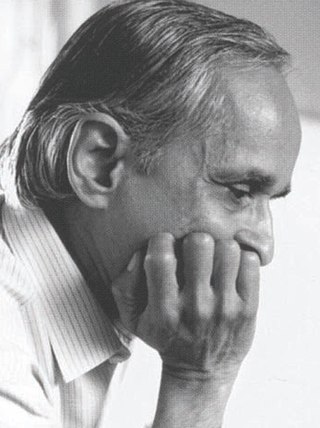
The Gateway of India is an arch-monument completed in 1924 on the waterfront of Mumbai (Bombay), India. It was erected to commemorate the landing of George V for his coronation as the Emperor of India in December 1911 at Strand Road near Wellington Fountain. He was the first British monarch to visit India.

Aurangabad, officially known as Chhatrapati Sambhaji Nagar, also spelt Chhatrapati Sambhajinagar, is a city in the Indian state of Maharashtra. It is the administrative headquarters of Aurangabad district and is the largest city in the Marathwada region. Located on a hilly upland terrain in the Deccan Traps, Aurangabad is the fifth-most populous urban area in Maharashtra after Mumbai, Pune, Nagpur and Nashik with a population of 1,175,116. The city is known as a major production center of cotton textile and artistic silk fabrics. Several prominent educational institutions, including Dr. Babasaheb Ambedkar Marathwada University, are located in the city. The city is also a popular tourism hub, with tourist destinations like the Ajanta and Ellora caves lying on its outskirts, both of which have been designated as UNESCO World Heritage Sites since 1983. Other tourist attractions include the Aurangabad Caves, Devagiri Fort, Grishneshwar Temple, Jama Mosque, Bibi Ka Maqbara, Himayat Bagh, Panchakki and Salim Ali Lake. Historically, there were 52 Gates in Aurangabad, some of them extant, because of which Aurangabad is nicknamed as the "City of Gates". In 2019, the Aurangabad Industrial City (AURIC) became the first greenfield industrial smart city of India under the country's flagship Smart Cities Mission.

The Taj Mahal Palace is a heritage, five-star, luxury hotel in the Colaba area of Mumbai, Maharashtra, India, situated next to the Gateway of India. Built in the Indo-Saracenic style, it opened in 1903 as the Taj Mahal Hotel and has historically often been known simply as "The Taj". The hotel is named after the Taj Mahal, which is located in the city of Agra approximately 1,050 kilometres (650 mi) from Mumbai. It has been considered one of the finest hotels in the East since the time of the British Raj. The hotel was one of the main targets in the 2008 Mumbai attacks.

The Deccan Odyssey is an Indian luxury train modeled on the Palace on Wheels luxury train and put into service to boost tourism on the Maharashtra route of the Indian Railways. The train, owned by travel company Cox & Kings since 2014, takes visitors on a variety of seven night, eight day trips across Maharashtra.

Watson's Hotel, now known as the Esplanade Mansion, located in the Kala Ghoda area of Mumbai (Bombay), is India's oldest surviving cast iron building. It is probably the oldest surviving multi-level fully cast-iron framed building in the world, being three years earlier than the Menier Chocolate Factory in Noisiel, France, which are both amongst the few ever built. Named after its original owner, John Watson, the cast and wrought iron structure of the building was prefabricated in England, and it was constructed between 1867 and 1869.

Claude Batley F.R.I.B.A., F.I.A.A., was an English architect who as practitioner, teacher and President of the Indian Institute of Architects from 1921 to 1923, played an influential role in development of modern architecture in India in the first half of the 20th century.

Aurangabad district, officially known as Chhatrapati Sambhaji Nagar district, is one of the 36 districts of the state of Maharashtra in western India. It borders the districts of Nashik to the west, Jalgaon to the north, Jalna to the east, and Ahmednagar to the south. The city of Aurangabad houses the district's administrative headquarters. The district has an area of 10,100 km2, of which 37.55% is urban and the rest is rural. Aurangabad District is a major tourism region in Marathwada.

Indo-Islamic architecture is the architecture of the Indian subcontinent produced by and for Islamic patrons and purposes. Despite an initial Arab presence in Sindh, the development of Indo-Islamic architecture began in earnest with the establishment of Delhi as the capital of the Ghurid dynasty in 1193. Succeeding the Ghurids was the Delhi Sultanate, a series of Central Asian dynasties that consolidated much of North India, and later the Mughal Empire by the 15th century. Both of these dynasties introduced Islamic architecture and art styles from West Asia into the Indian subcontinent.
Taj Hotels is a chain of luxury hotels and a subsidiary of the Indian Hotels Company Limited, headquartered in Mumbai, India. Incorporated by Jamsetji Tata in 1902, the company is a part of the Tata Group. The company employed over 20,000 people in the year 2010. The company has been ranked as the World’s Strongest Hotel Brand in 2022 and India’s Strongest Brand as per Brand Finance Hotels 50 Report 2022 and India 100 Report 2020, 2022 and 2023.

The Indian Hotels Company Limited (IHCL) is an Indian hospitality company that manages a portfolio of hotels, resorts, jungle safaris, palaces, spas and in-flight catering services. The company is part of India's Tata Group. IHCL was founded in 1902 by Jamsetji Tata and is headquartered in Mumbai where its flagship hotel Taj Mahal Palace Hotel is also located.

The 2008 Mumbai attacks were a series of terrorist attacks that took place in November 2008, when 10 members of Lashkar-e-Taiba, a militant Islamist organisation from Pakistan, carried out 12 coordinated shooting and bombing attacks lasting four days across Mumbai. The attacks, which drew widespread global condemnation, began on Wednesday 26 November and lasted until Saturday 29 November 2008. A total of 175 people died, including nine of the attackers, with more than 300 injured.
Jatin Das is an Indian painter, sculptor and muralist. He is counted amongst the leading contemporary artists of India.
The architecture of Mumbai blends Gothic, Victorian, Art Deco, Indo-Saracenic & Contemporary architectural styles. Many buildings, structures and historical monuments remain from the colonial era. Mumbai, after Miami, has the second largest number of Art Deco buildings in the world.

Jazz music in India originated in the 1920s in Mumbai and in Kolkata, where African-American jazz musicians performed. They inspired Goan musicians who then absorbed aspects of jazz into the sounds of India’s Hindi film music industry. There has been much interaction between Indian music and jazz music. An active jazz scene exists today in cities like Mumbai, Pune, Delhi, Goa, and Kolkata.

Maharashtra state in India is known for its Famous caves and cliffs. It is said that the varieties found in Maharashtra are wider than the caves and rock-cut architecture found in the rock cut areas of Egypt, Assyria, Persia and Greece. The Buddhist monks first started these caves in the 2nd century BC, in search of serene and peaceful environment for meditation, and they found these caves on the hillsides.

The Taj Mahal, an iconic structure in India, has inspired numerous replicas and derivatives. "The Taj", informally, is now a major tourist attraction in Agra, Uttar Pradesh, and has been regarded as one of the New Seven Wonders of the World. Since 1632, when Mughal emperor Shah Jahan began building the Taj to house the tomb of his favorite wife, Mumtaz Mahal, it has inspired many notable replicas, and major derivative structures include a 1678-started project of the emperor's grandson. Some are intended to be scale models or otherwise to be more or less faithful copies, and others are designed with mild or extreme interpretations of the Taj's architecture adapted to serve other purposes.

The Embassy of the United States of America in New Delhi is the diplomatic mission of the United States of America in the Republic of India. The Embassy is headed by the U.S. Ambassador to India. The embassy complex is situated on a 28-acre plot of land in Chanakyapuri, the diplomatic enclave of New Delhi, where most of the embassies are located. The embassy is also accredited to Bhutan with whom the United States maintains no formal relations.

Prabhakar Barwe was a pioneer of Modern Indian painting. He was active in Mumbai, India from the 1959 until his death in 1995. Influenced by the esoteric tradition of Tantric painting, Barwe along with G. R. Santosh, P. T. Reddy, K.C.S. Paniker, Biren De, Om Prakash, K. V. Haridasan, Prafulla Mohanti and Mahirwan Mamtani was considered part of the modernist movement Neo-Tantra.

Shiavax Dhanjibhoy Chavda was an Indian painter, illustrator and muralist. Known for his dynamic line drawings and paintings, Chavda's work mainly showcased the dancers and musicians from India and Southeast Asia.

















